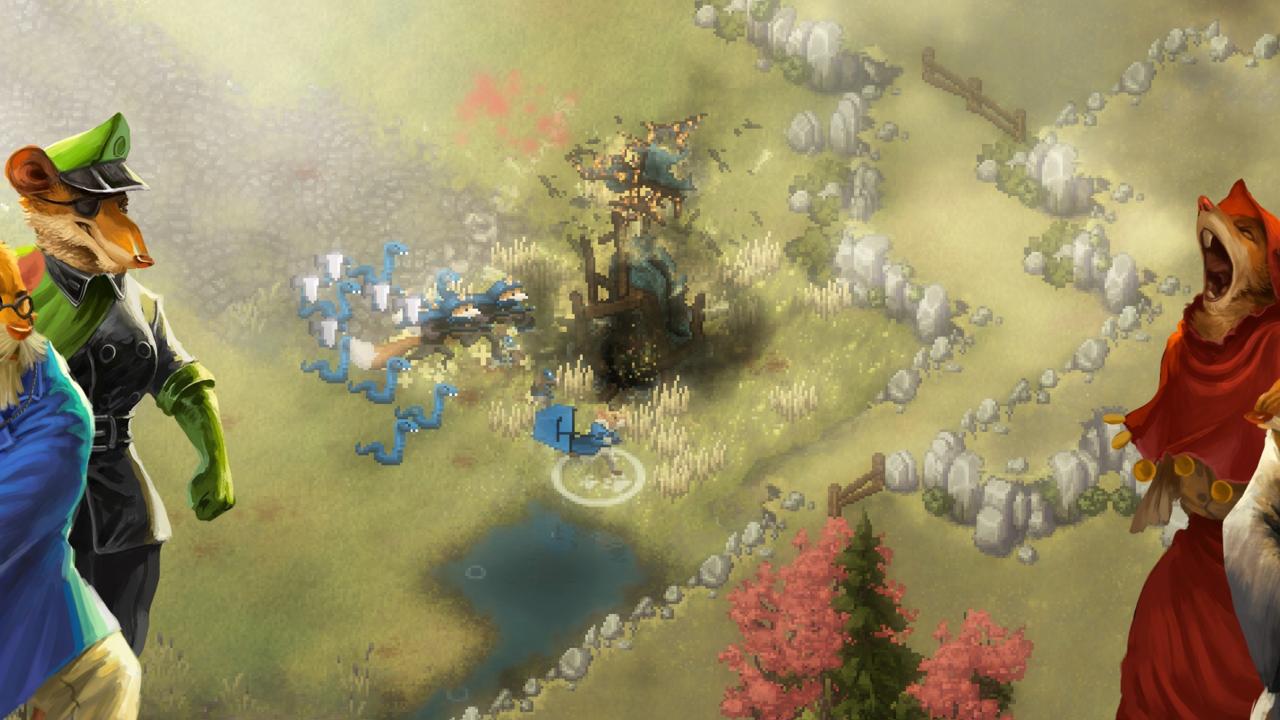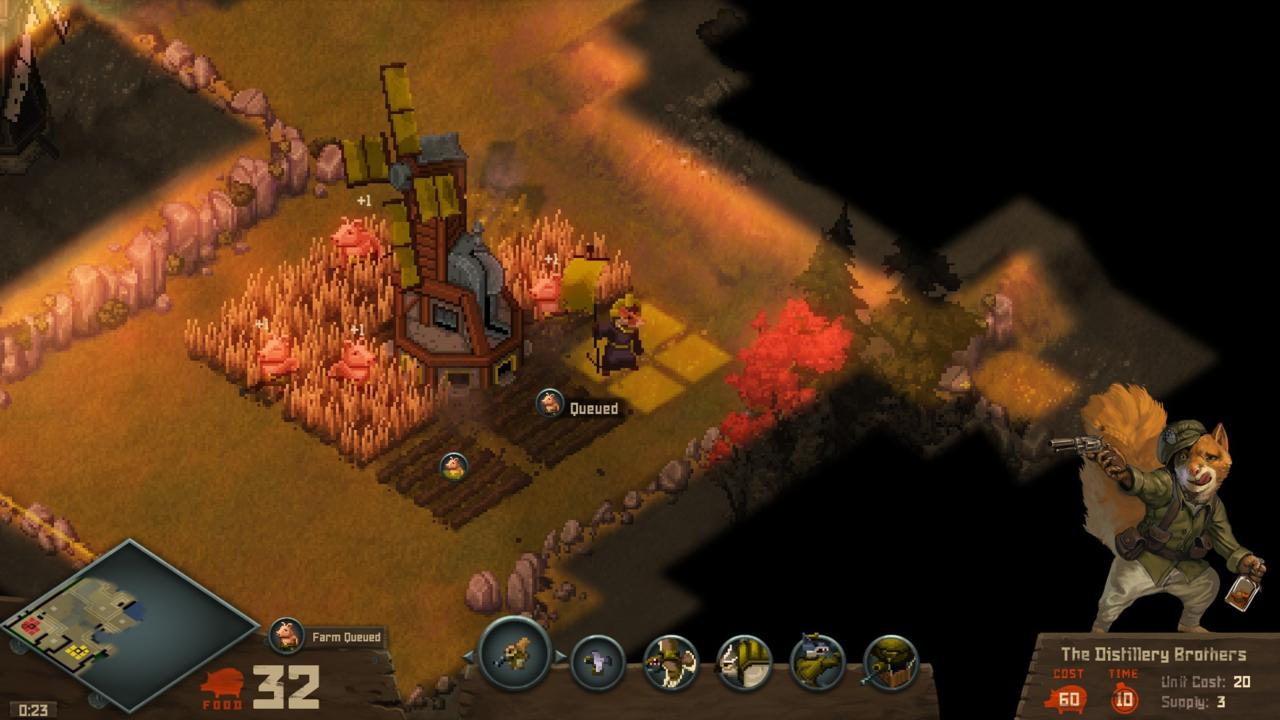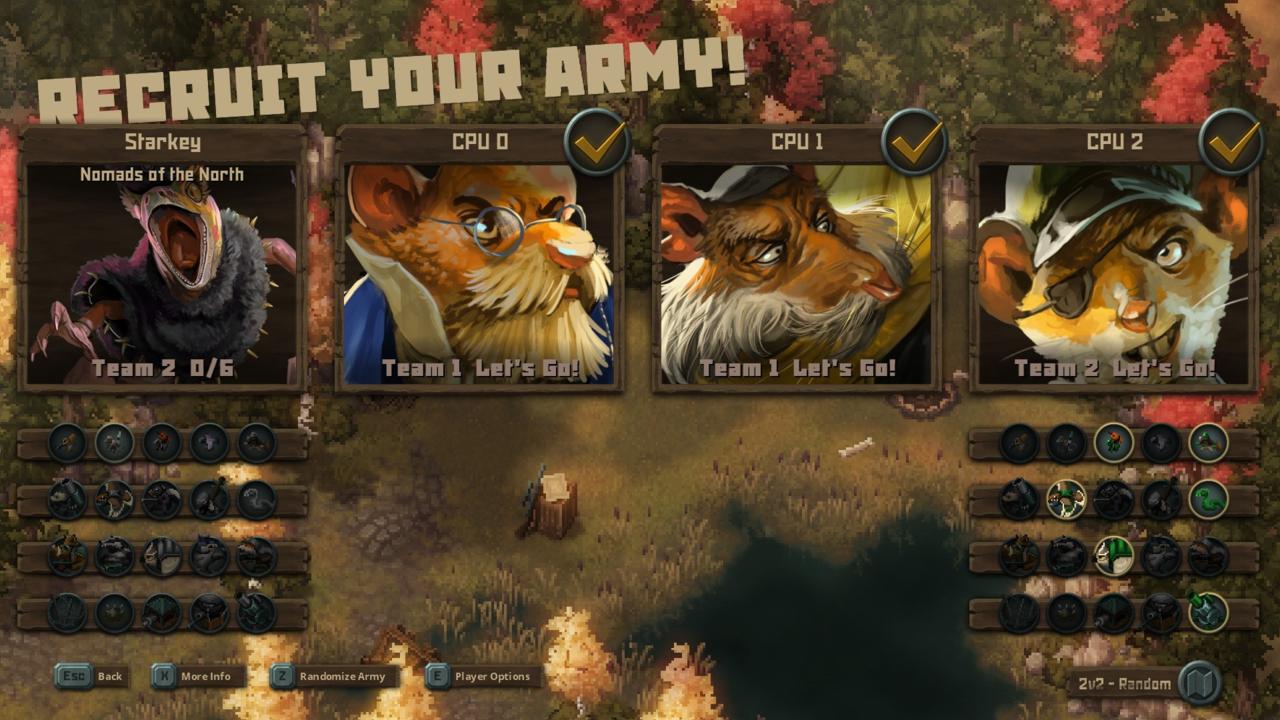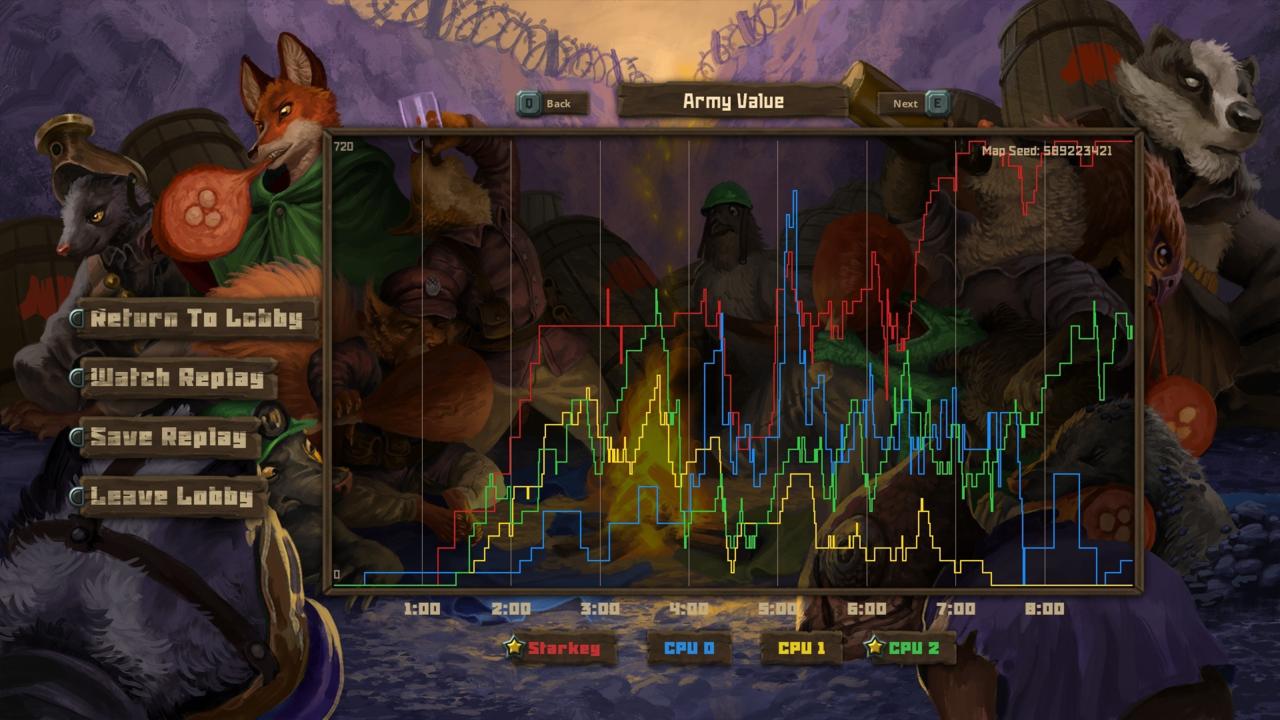Tooth and Tail is a bizarre cocktail of a dozen great ideas. It's a minimalist RTS that tosses out complex tech trees in favor of action-packed but accessible play. It's set vaguely in Eastern Europe in the 1910s, with both the Russian Revolution and World War I in full swing. Playing up the grim tumult of the era, Tooth and Tail also casts itself with all manner of cute--though ragged and crestfallen--critters. With so many disparate items, it's a wonder that Tooth and Tail manages to work at all, but it excels with but a few minor blemishes.
Superficially, Tooth and Tail looks the part of a standard RTS, but familiarity with genre staples isn’t required. Yes, you still have resources and units, and a "base," of sorts, but the similarities end there. Instead of using a cursor to drag and select groups of units, for example, you play a sole critter twirling your team's battle standard. Tooth and Tail simplifies a notoriously complex genre into a few fundamental, direct rules.

You need a gristmill to build farms. Farms are used to grow food. Food is spent on units, making more farms, and claiming more mills to make more farms. Before each match, you pick up to six units you want to be able to use from a pool of 20. You can only build near a gristmill. Finally, you marshal units to destroy your enemies' mills.
That simplicity is marvelous. Tooth and Tail distills strategy games to its essentials--building out armies, growing stronger, and the dynamic, puzzle-like nature of play--and gets rid of nearly everything else. That means ludicrous actions per minute no longer matter.Randomly-generated maps keep others from gaining an unfair advantage with terrain knowledge. The playing field is almost always as level as it can be, leaving commanders to compete on raw strategic/tactical prowess.
Instead of building out specialized scout units and sending them to collect telemetry on the map, your commander does it on their own. The cost, of course, is that if you're scouting, you can't build because you wouldn't be near the mill. You can't attack on your own, either. This keeps you from rushing or spawning tons of machine-gun-toting squirrels near your foes' farms and claiming victory. You can, however, burrow back at any time to queue up more soldiers before heading out again. This guides a core pace to the game--rush out and study before retreating to build. It's a simple pattern that's welcoming to new players.

Strategy veterans may balk and think that this takes streamlining a step too far. After all, without unit upgrades and heavy micromanagement, it would seem that there's not much else you can do, leaving skilled folks idle and bored. That issue doesn't come up much in play, though. Because maps are random, and you never know which six units other players will bring, most start off with similar levels of knowledge. Advanced players will, of course, have a deeper understanding of which units can cover for what weaknesses, but they won't be able to use that to counter pick either the roster or the map. Instead, their play becomes much more reactive. They have to scout like anyone else, and they have to adapt to whichever assortment of woodland animals hit the map.
All this does not make expertise meaningless. When the only thing under your control are which parts of the map you can see, what you're building, and whether or not you're advancing or retreating, each of those choices carries much more weight. Food also isn't unlimited, and unless you were nabbing territory in the early game, you'll run dry (and starve) in short order. This keeps the pace brisk, and, when combined with the limitations inherent in controlling one commander vs. having a nigh-omniscient view of the map means that the action almost always hits at the edge of what feels manageable. Tooth and Tail supports up to four players, and when everyone's in, things get chaotic. With all four of you fielding armies of tiny, skittering squirrels and badgers or hawks and owls, things get messy fast. And, this is where Tooth and Tail begins to shine.
Short, mediocre campaign aside, there's little here to muck with the essential beauty of this streamlined RTS.
As mentioned, at any point there could be 20 different units on the field. Unlike your StarCrafts or your Sins of a Solar Empires, though, your arrangement of units are unique each round. You pick your commander--who will hail from one of four factions--and then you select your roster. Neither option has any impact on the other, but which critters you pick will have a huge impact on strategy.
Unit types range from defensive artillery to flamethrowers and run the gamut of classic military roles. Medics, transports, gun nests, heavies, engineers, etc. get their due. But big decisions hinge on being able to read the lay of a battle in an instant. You only have a couple of buttons with which to command your troops. One order will have them pressing forward, another will pull them back. The ability to understand, at a glance, which armies have what units and who has the advantage is essential. Lacking the simple visual cues of a uniting theme or aesthetic as in other strategy games, Tooth and Tail has to make each of these figures clear and recognizable in the heat of battle. And, thanks to stellar art and crisp animations, that's never an issue. Each unit has its own heft--or lack thereof--and they're all recognizable by silhouette with the possible exception of a handful of the smaller scrappers. All you need do, then, is worry about a small band of critical choices.

Because of that purity, playing with a controller feels as tight if not better than a standard mouse and keyboard. The analogue stick is a touch more responsive than otherwise limiting WASD keys. This also makes it one of the few games to nail real-time strategy on the console. And, like with Pikmin, the relative straightforward approach to tactical challenges doesn't come with any costs.
Tooth and Tail picks the right premise, with the right pacing, and the right amount of streamlining to keep every second of a match feeling heated. Games run their course in 10 minutes or less, and that brevity feels revolutionary. Matches in most other RTS games run half-an-hour or longer, limiting who can pick up and play a round here and there. That doesn't need to be, though. Tooth and Tail shows that you can have a zippy, engaging strategy game that's satisfying, nuanced, and accessible.
My only real complaint is that, while the game is deep, you'll want to play with friends. A single-player campaign gives you a basic introduction to the world through a tongue-in-cheek presentation of different political factions. There's a civil war on, and the throngs of fluffy animals are all fighting to be the one who doesn't get chomped by the rest. Each loosely aligns to a real-world political philosophy, but they are all pushed so far into the realm of the ridiculous that none of them come as either mean-spirited or pointed critiques of anything tangible. These characters are fodder for the game's morose sense of humor, and it works. It is not, however, as groundbreaking as the bulk of play, and it doesn't amount to much beyond progressive, contextualized challenges.

Campaign maps are procedural, which keeps things from getting stale but, given the more specific mission objectives for the campaign, it also isn't as balanced as its free-for-all multiplayer counterpart. You will, at some point, end up with a map that feels stacked against you. And, luck of the draw though it may have been, it still frustrates. Then again, all you need do is wait out the 5-8 minute match and you'll get a new map to try again.
Short, mediocre campaign aside, there's little here to muck with the essential beauty of this streamlined RTS. Nothing else in recent memory offers quite the same white-knuckle thrills. Scouting and modifying your unit composition with up-to-the-minute info on enemy forces, rallying them into battle, continuing to grab up new farmland to fuel your fluffy hordes, and switching between them every fifteen seconds is divine.
Rotating through the band of 20 fighters will offer plenty of depth on its own, too. There's plenty of room to fake out foes by overbuilding one type and feinting a foe into countering that so you can sweep them with your own reserves. If you don't have quite the squads you need to deal with enemies in the best way, you'll have to adapt -- and strong variety will give you the tools to come up with unique combinations and tactics on the fly.
When all of that comes together in a tight, four-player battle royale, it is a thing of beauty.






